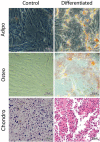Mesenchymal stem cell therapy promotes the improvement and recovery of renal function in a preclinical model
- PMID: 27275667
- PMCID: PMC4910560
- DOI: 10.1590/1678-4685-GMB-2015-0178
Mesenchymal stem cell therapy promotes the improvement and recovery of renal function in a preclinical model
Abstract
Acute renal failure (ARF) is an extremely important public health issue in need of novel therapies. The present study aimed to evaluate the capacity of mesenchymal stem cell (MSC) therapy to promote the improvement and recovery of renal function in a preclinical model. Wistar rats were used as the experimental model, and our results show that cisplatin (5mg/kg) can efficiently induce ARF, as measured by changes in biochemical (urea and creatinine) and histological parameters. MSC therapy performed 24h after the administration of chemotherapy resulted in normalized plasma urea and creatinine levels 30 and 45d after the onset of kidney disease. Furthermore, MSC therapy significantly reduced histological changes (intratubular cast formation in protein overload nephropathy and tubular hydropic degeneration) in this ARF model. Thus, considering that current therapies for ARF are merely palliative and that MSC therapy can promote the improvement and recovery of renal function in this model system, we suggest that innovative/alternative therapies involving MSCs should be considered for clinical studies in humans to treat ARF.
Figures





References
-
- Angeli JP, Ribeiro LR, Gonzaga ML, Soares S de A, Ricardo MP, Tsuboy MS, Stidl R, Knasmueller S, Linhares RS, Mantovani MS. Protective effects of beta-glucan extracted from Agaricus blazei against chemically induced DNA damage in human lymphocytes. Cell Biol Toxicol. 2006;22:285–291. - PubMed
-
- Angeli JP, Ribeiro LR, Angeli JL, Mantovani MS. Protective effects of beta-glucan from barley against benzo[a]pyrene-induced DNA damage in hepatic cell HepG2. Exp Toxicol Pathol. 2009a;61:83–89. - PubMed
-
- Angeli JP, Ribeiro LR, Bellini MF, Mantovani MS. Beta-glucan extracted from the medicinal mushroom Agaricus blazei prevents the genotoxics effects of benzo[a]pyrene in the human hepatoma cel line HepG2. Arch Toxicol. 2009b;83:81–86. - PubMed
-
- Best TM, Fiebig R, Corr DT, Brickson S, Ji L. Free radical activity, antioxidant enzyme, and glutathione changes with muscle stretch injury in rabbits. J Appl Physiol. 1999;87:74–82. - PubMed
-
- Brickson S, Hollander J, Corr DT, Ji LL, Best TM. Oxidant production and immune response after stretch injury in skeletal muscle. Med Sci Sports Exerc. 2001;33:2010–2015. - PubMed
LinkOut - more resources
Full Text Sources
Other Literature Sources
Miscellaneous

